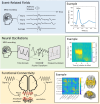Paediatric magnetoencephalography and its role in neurodevelopmental disorders
- PMID: 38976633
- PMCID: PMC11417392
- DOI: 10.1093/bjr/tqae123
Paediatric magnetoencephalography and its role in neurodevelopmental disorders
Abstract
Magnetoencephalography (MEG) is a non-invasive neuroimaging technique that assesses neurophysiology through the detection of the magnetic fields generated by neural currents. In this way, it is sensitive to brain activity, both in individual regions and brain-wide networks. Conventional MEG systems employ an array of sensors that must be cryogenically cooled to low temperature, in a rigid one-size-fits-all helmet. Systems are typically designed to fit adults and are therefore challenging to use for paediatric measurements. Despite this, MEG has been employed successfully in research to investigate neurodevelopmental disorders, and clinically for presurgical planning for paediatric epilepsy. Here, we review the applications of MEG in children, specifically focussing on autism spectrum disorder and attention-deficit hyperactivity disorder. Our review demonstrates the significance of MEG in furthering our understanding of these neurodevelopmental disorders, while also highlighting the limitations of current instrumentation. We also consider the future of paediatric MEG, with a focus on newly developed instrumentation based on optically pumped magnetometers (OPM-MEG). We provide a brief overview of the development of OPM-MEG systems, and how this new technology might enable investigation of brain function in very young children and infants.
Keywords: ADHD; ASD; MEG; magnetoencephalography; neurodevelopment.
© The Author(s) 2024. Published by Oxford University Press on behalf of the British Institute of Radiology.
Conflict of interest statement
M.J.B. is a director of and holds founding equity in Cerca Magnetics Limited, a spin-out company whose aim is to commercialize aspects of OPM-MEG technology. M.J.B. holds the following patents: UK Patent Application No. 2015427.4, Short Title: Magnetoencephalography Method and System; UK Patent Application No. 2106961.2, Short Title: A magnetic shield; UK Patent Application No. 2108360.5, Short Title: Magnetoencephalography Apparatus. All other authors have no competing interests to declare.
Figures





Similar articles
-
Characterizing Inscapes and resting-state in MEG: Effects in typical and atypical development.Neuroimage. 2021 Jan 15;225:117524. doi: 10.1016/j.neuroimage.2020.117524. Epub 2020 Nov 2. Neuroimage. 2021. PMID: 33147510
-
Applications of OPM-MEG for translational neuroscience: a perspective.Transl Psychiatry. 2024 Aug 24;14(1):341. doi: 10.1038/s41398-024-03047-y. Transl Psychiatry. 2024. PMID: 39181883 Free PMC article. Review.
-
Multi-channel whole-head OPM-MEG: Helmet design and a comparison with a conventional system.Neuroimage. 2020 Oct 1;219:116995. doi: 10.1016/j.neuroimage.2020.116995. Epub 2020 May 29. Neuroimage. 2020. PMID: 32480036 Free PMC article.
-
Magnetoencephalography with optically pumped magnetometers (OPM-MEG): the next generation of functional neuroimaging.Trends Neurosci. 2022 Aug;45(8):621-634. doi: 10.1016/j.tins.2022.05.008. Epub 2022 Jun 30. Trends Neurosci. 2022. PMID: 35779970 Free PMC article. Review.
-
On-Scalp Optically Pumped Magnetometers versus Cryogenic Magnetoencephalography for Diagnostic Evaluation of Epilepsy in School-aged Children.Radiology. 2022 Aug;304(2):429-434. doi: 10.1148/radiol.212453. Epub 2022 May 3. Radiology. 2022. PMID: 35503013
Cited by
-
Virtual environments as a novel and promising approach in (neuro)diagnosis and (neuro)therapy: a perspective on the example of autism spectrum disorder.Front Neurosci. 2025 Jan 15;18:1461142. doi: 10.3389/fnins.2024.1461142. eCollection 2024. Front Neurosci. 2025. PMID: 39886337 Free PMC article.
-
Hallmarks of Brain Plasticity.Biomedicines. 2025 Feb 13;13(2):460. doi: 10.3390/biomedicines13020460. Biomedicines. 2025. PMID: 40002873 Free PMC article. Review.
-
Pushing the boundaries of MEG based on optically pumped magnetometers towards early human life.Imaging Neurosci (Camb). 2025 Mar 13;3:imag_a_00489. doi: 10.1162/imag_a_00489. eCollection 2025. Imaging Neurosci (Camb). 2025. PMID: 40800963 Free PMC article.
References
-
- Baillet S. Magnetoencephalography for brain electrophysiology and imaging. Nat Neurosci. 2017;20(3):327-339. - PubMed
-
- Perucca P, Scheffer IE, Kiley M.. The management of epilepsy in children and adults. Med J Aust. 2018;208(5):226-233. - PubMed
-
- Ryvlin P, Cross JH, Rheims S.. Epilepsy surgery in children and adults. Lancet Neurol. 2014;13(11):1114-1126. - PubMed
Publication types
MeSH terms
Grants and funding
LinkOut - more resources
Full Text Sources

